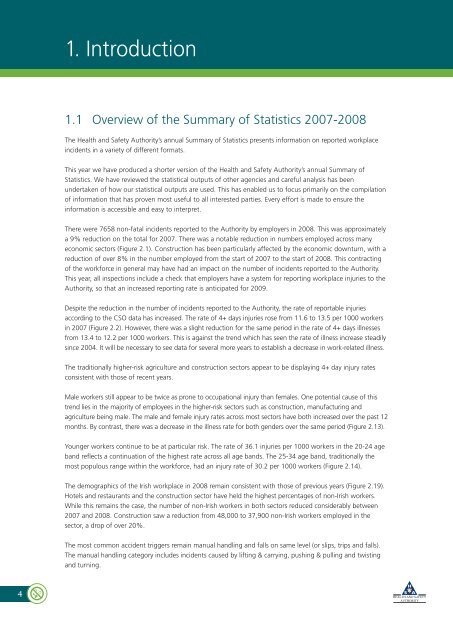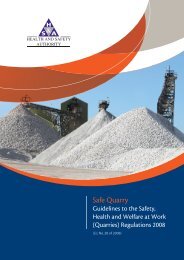Summary of Workplace Injury, Illness and Fatality Statistics 2007-2008
Summary of Workplace Injury, Illness and Fatality Statistics 2007-2008
Summary of Workplace Injury, Illness and Fatality Statistics 2007-2008
You also want an ePaper? Increase the reach of your titles
YUMPU automatically turns print PDFs into web optimized ePapers that Google loves.
1. Introduction<br />
1.1 Overview <strong>of</strong> the <strong>Summary</strong> <strong>of</strong> <strong>Statistics</strong> <strong>2007</strong>-<strong>2008</strong><br />
The Health <strong>and</strong> Safety Authority’s annual <strong>Summary</strong> <strong>of</strong> <strong>Statistics</strong> presents information on reported workplace<br />
incidents in a variety <strong>of</strong> different formats.<br />
This year we have produced a shorter version <strong>of</strong> the Health <strong>and</strong> Safety Authority’s annual <strong>Summary</strong> <strong>of</strong><br />
<strong>Statistics</strong>. We have reviewed the statistical outputs <strong>of</strong> other agencies <strong>and</strong> careful analysis has been<br />
undertaken <strong>of</strong> how our statistical outputs are used. This has enabled us to focus primarily on the compilation<br />
<strong>of</strong> information that has proven most useful to all interested parties. Every effort is made to ensure the<br />
information is accessible <strong>and</strong> easy to interpret.<br />
There were 7658 non-fatal incidents reported to the Authority by employers in <strong>2008</strong>. This was approximately<br />
a 9% reduction on the total for <strong>2007</strong>. There was a notable reduction in numbers employed across many<br />
economic sectors (Figure 2.1). Construction has been particularly affected by the economic downturn, with a<br />
reduction <strong>of</strong> over 8% in the number employed from the start <strong>of</strong> <strong>2007</strong> to the start <strong>of</strong> <strong>2008</strong>. This contracting<br />
<strong>of</strong> the workforce in general may have had an impact on the number <strong>of</strong> incidents reported to the Authority.<br />
This year, all inspections include a check that employers have a system for reporting workplace injuries to the<br />
Authority, so that an increased reporting rate is anticipated for 2009.<br />
Despite the reduction in the number <strong>of</strong> incidents reported to the Authority, the rate <strong>of</strong> reportable injuries<br />
according to the CSO data has increased. The rate <strong>of</strong> 4+ days injuries rose from 11.6 to 13.5 per 1000 workers<br />
in <strong>2007</strong> (Figure 2.2). However, there was a slight reduction for the same period in the rate <strong>of</strong> 4+ days illnesses<br />
from 13.4 to 12.2 per 1000 workers. This is against the trend which has seen the rate <strong>of</strong> illness increase steadily<br />
since 2004. It will be necessary to see data for several more years to establish a decrease in work-related illness.<br />
The traditionally higher-risk agriculture <strong>and</strong> construction sectors appear to be displaying 4+ day injury rates<br />
consistent with those <strong>of</strong> recent years.<br />
Male workers still appear to be twice as prone to occupational injury than females. One potential cause <strong>of</strong> this<br />
trend lies in the majority <strong>of</strong> employees in the higher-risk sectors such as construction, manufacturing <strong>and</strong><br />
agriculture being male. The male <strong>and</strong> female injury rates across most sectors have both increased over the past 12<br />
months. By contrast, there was a decrease in the illness rate for both genders over the same period (Figure 2.13).<br />
Younger workers continue to be at particular risk. The rate <strong>of</strong> 36.1 injuries per 1000 workers in the 20-24 age<br />
b<strong>and</strong> reflects a continuation <strong>of</strong> the highest rate across all age b<strong>and</strong>s. The 25-34 age b<strong>and</strong>, traditionally the<br />
most populous range within the workforce, had an injury rate <strong>of</strong> 30.2 per 1000 workers (Figure 2.14).<br />
The demographics <strong>of</strong> the Irish workplace in <strong>2008</strong> remain consistent with those <strong>of</strong> previous years (Figure 2.19).<br />
Hotels <strong>and</strong> restaurants <strong>and</strong> the construction sector have held the highest percentages <strong>of</strong> non-Irish workers.<br />
While this remains the case, the number <strong>of</strong> non-Irish workers in both sectors reduced considerably between<br />
<strong>2007</strong> <strong>and</strong> <strong>2008</strong>. Construction saw a reduction from 48,000 to 37,900 non-Irish workers employed in the<br />
sector, a drop <strong>of</strong> over 20%.<br />
The most common accident triggers remain manual h<strong>and</strong>ling <strong>and</strong> falls on same level (or slips, trips <strong>and</strong> falls).<br />
The manual h<strong>and</strong>ling category includes incidents caused by lifting & carrying, pushing & pulling <strong>and</strong> twisting<br />
<strong>and</strong> turning.<br />
4

















